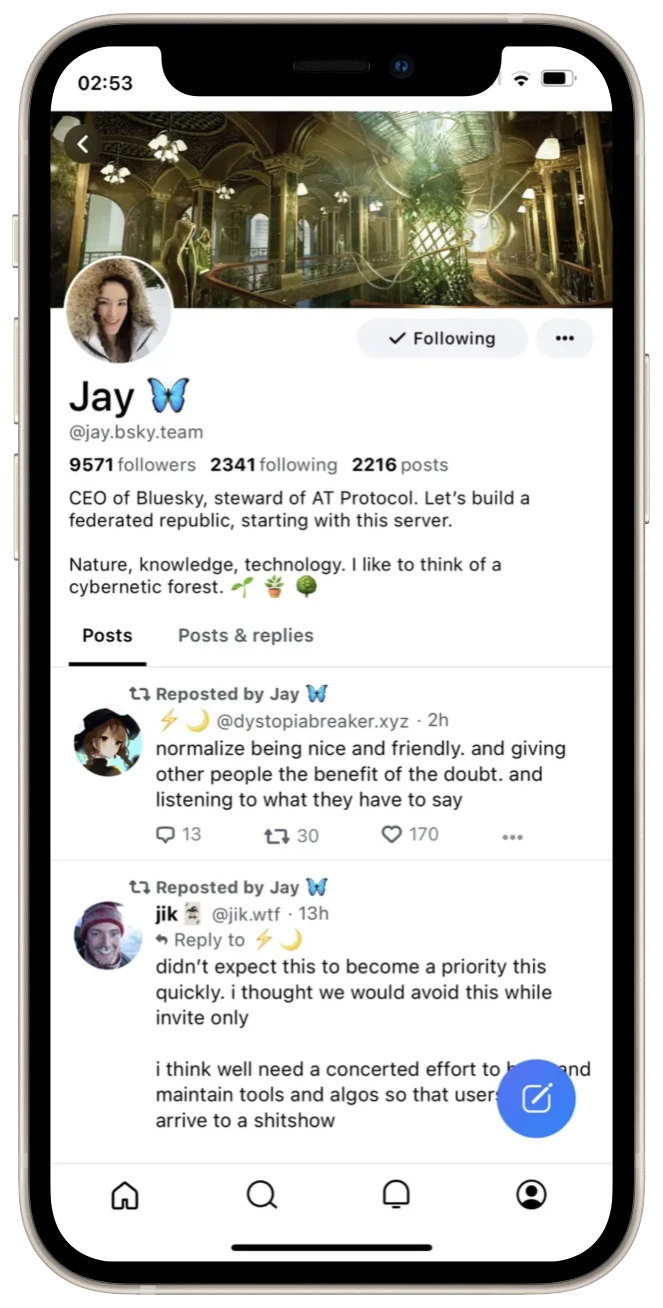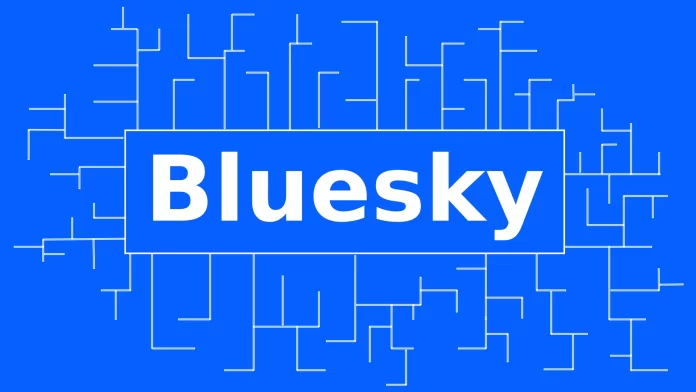Unlike the typical centralized platforms we’re used to, such as Twitter or Facebook, Bluesky is championing a decentralized approach. This concept may sound a bit complex initially, but decentralization is essentially about returning power to the users. It signifies a shift away from the dominance of single corporations over our digital interactions. It moves towards a more democratic model where users have more control and ownership of their online presence.
Bluesky isn’t the first to offer a decentralized approach; there’s also a Mastodon. It operates via numerous individual servers or “instances,” which can range in focus from specific geographical locations to shared interests.
Mastodon first made its appearance in 2016, gaining fame for its self-hosted social media services. Its core principle also lies in decentralization, where servers can be joined as per users’ interests. After several years of hard work, Mastodon’s stable release was globally rolled out on April 4, 2023, captivating users with its ability to cater to diverse interests and facilitate interaction within communities.
Like a Bluesky, Mastodon sees surges when something goes wrong on Twitter; according to its founder Eugen Rochko, it gained 110,000 users on July 3, 2023, following Twitter limits to the amount of posts users can see.
What is Bluesky?
Bluesky is an open-source social network, which means its code and inner workings are publicly available for anyone to examine, contribute to, or adapt for their purposes. This transparency underpins Bluesky’s commitment to democratizing social media. It’s a stark contrast to the opaqueness of most social networks, where what happens behind the scenes is hidden from users. With Bluesky, you know exactly what’s happening under the hood because it’s all out there for you to see.
Bluesky’s design is simple, intuitive, and easy to use. And it seems almost like Twitter; you may not even see the difference at first glance.

Many people find getting started with new platforms daunting because they have to navigate a completely new interface. Bluesky aims to remove this barrier by creating an interface that feels familiar. It goes even a step further by giving users control over their timelines. It allows them to choose the algorithms that dictate what content they see and when they see it. This is a significant shift from the usual practice where the platform determines what users should see, often leading to information bubbles, when you see only information that aligns with your worldview and interests.
But the thing which makes it unique is not the interface but a new AT protocol.
The concept and AT protocol
Bluesky’s decentralized social media network concept tries to reimagine how users interact with their digital public space. Unlike traditional platforms where single entities control the data, Bluesky declares a community-maintained, open-source, interoperable network where users hold authority over their own data.
Before we approach the AT protocol, the central idea of this new service, I want to make a small disclaimer: I still don’t understand 100% how it works, and they don’t comprehensively explain how it works. So everything written below is just a concept of how it should work, but I never tested how that works in real life.
Authenticated Transfer (AT) protocol is central to the app, an open, decentralized standard for social media that safeguards user data while boosting account portability across servers. It challenges the limitations of existing federated networks by addressing the issue of “account portability,” which refers to the user’s ability to retain their digital identities, even when servers are shut down or changed.
How does it work?
Data repositories work much like GitHub repositories, as hubs for database records containing users’ public activities. In contrast, DIDs offer a secure and privacy-protected way of using digital identities across various platforms and blockchains. It aligns with the W3C standard, ensuring compliance with established digital identity requirements.
The AT protocol also introduces a schema-based interoperation framework called Lexicon to enhance coordination across different servers, bolstering the interoperability facet of Bluesky’s vision. To cater to the diverse needs of the network, the protocol differentiates between “small-world” and “big-world” networking, accommodating both intimate, specific uses like mentions, replies, and DMs, as well as large-scale dynamics such as followers, shares, likes, and content discovery.
In an effort to give users more control over their social media experience, the AT protocol promotes an “open algorithms mode,” allowing users to choose and modify the algorithm that dictates their feed. By establishing trust through the use of self-authenticating data and verifiable computations, the protocol ensures privacy and opens avenues for auditing service performance.
Bluesky’s AT protocol isn’t blockchain; it’s a federative network.
The Connection and the Funding
Bluesky was initially conceptualized within Twitter in 2019. By 2022, Bluesky had grown beyond its origin and became an independent entity, a milestone facilitated by a significant injection of $13 million in funding. The move towards independence was backed by one of Twitter’s co-founders, Jack Dorsey, who continues to support Bluesky’s vision by serving on its board.
The funding has enabled Bluesky to actively pursue the development of its AT protocol and Bluesky Social, a decentralized social application built on the AT protocol. This app is currently in private beta testing, showcasing Bluesky’s commitment to fostering a more user-controlled, interoperable, and transparent social media landscape.
Leading Bluesky’s initiatives is CEO Jay Graber. Graber’s expertise in developing decentralized web protocols and blockchain networks underpins the company’s innovative trajectory. Her role in steering Bluesky is a testament to her belief in the transformative power of decentralized social networking.
Bluesky vs Mastodon
Bluesky and Mastodon are two distinct initiatives in the realm of decentralized social media, but they have different philosophies, designs, and implementations.
- Origins and Purpose: Mastodon was created as an open-source, federated alternative to Twitter, aiming to shift the control of data from corporations to users. It’s a ready-to-use social network with a user-friendly interface. On the other hand, Bluesky was initiated by Twitter itself (but now that’s a separate company), and its purpose is to create open protocols for social media rather than creating a direct competitor to existing platforms. Its primary goal is to foster interoperability among various social platforms.
- Implementation: Mastodon is already up and running, with thousands of “instances” or servers that are part of the “Fediverse.” Users can post, follow, like, and boost posts, and each instance can establish its own rules and community standards. Bluesky is still under development, and rather than creating an alternative social network, it aims to create a protocol (Authenticated Transfer protocol) that would enable account portability, interoperability, algorithmic choices, and a higher level of user control over data.
- Account Portability: One of the key differences lies in the approach to account portability. In Mastodon, if an instance is shut down, users can lose their identities tied to their accounts on that specific server. Through its Authenticated Transfer protocol, Bluesky is developing a system to maintain social graphs between providers and protect users from sudden shutdowns. It aims to use data repositories and decentralized identifiers (DIDs) to increase account portability across servers.
- Decentralization Approach: Mastodon operates on a federated model, where each instance operates independently but can interact with others. Bluesky aims to create a hybrid model, adding peer-to-peer characteristics to the federated model, which could provide additional flexibility and control to the users.
- Control over Algorithms: Bluesky intends to give users more control over the algorithms that dictate what content they see in their feeds. This level of control is not a feature currently inherent in the Mastodon network.
While both projects aim to decentralize social media, Mastodon is a working alternative to Twitter, while Bluesky aims to develop a new protocol to transform how social media platforms function on a fundamental level.
How to join a Bluesky?
If you’re eager to join Bluesky, your best bet is to place yourself on their waitlist. You simply visit the Bluesky beta website and input your email address to do this. From there, all that’s left is patiently waiting for an invitation directly to your inbox.
However, this isn’t the only pathway to acquire an invite code for the platform. Current users occasionally receive invite codes to share, so having a connection already inside the network might prove to be a quicker way in. Yet, this has inadvertently created a market for Bluesky invite codes, with some individuals seeking monetary gains from their excess codes.
Despite the allure, we highly advise against purchasing Bluesky codes. The risk of being scammed is significant, as there’s nothing preventing the seller from accepting your money and providing a fake or expired code. Moreover, it’s important to remember that Bluesky, like any other social media network, will eventually open its doors to everyone, rendering these codes obsolete. So, it’s best to be patient and wait for your official invitation from Bluesky.
Bluesky perspectives
Despite innovative technology behind it. I’m not sure Bluesky can successfully compete with Twitter. The one thing that makes the social platform mainstream is its community, where you can join it and find users with the same interests.
Now it’s in the early stages of development, Bluesky is limited by an invites-only sign-in approach, unfinished features, and potential technical glitches, which could hamper the user experience.
Since it relies heavily on the goodwill of its user base to respect and protect the decentralized system, there are concerns about the potential for misuse and abuse of the platform. Bluesky’s adoption and success depend greatly on its compatibility and integration with existing social media platforms.
Bluesky could become isolated and struggle to gain traction if these platforms reject its interoperability. Another major weakness is the platform’s scalability. Its ambition to operate on a global scale is commendable, but it remains to be seen how well it can handle a large influx of users while maintaining stability and performance.
Lastly, despite the provision of invites to encourage growth, the limited access may be viewed as a barrier, discouraging potential users from joining the platform.





